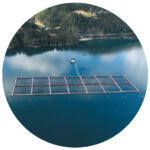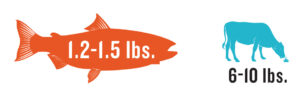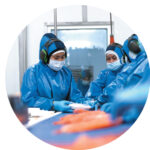1. Kituyi, M., & Thomson, P. (2018, July 13). 90% of fish stocks are used up – fisheries subsidies must stop emptying the ocean. Retrieved July, 2019, from https://www.weforum.org/agenda/2018/07/fish-stocks-are-used-up-fisheries-subsidies-must-stop/
2. International Salmon Farmers Association 2018 Report. (n.d.). Retrieved July, 2019, from https://sjomatnorge.no/wp-content/uploads/2018/06/ISFA-Report-2018-FINAL-FOR-WEB.pdf
3. Cahu, C., Salen, P., & De Lorgeril, M. (2004). Farmed and wild fish in the prevention of cardiovascular diseases: Assessing possible differences in lipid nutritional values. Nutrition, Metabolism and Cardiovascular Diseases,14(1), 34-41. Retrieved July, 2019, from https://www.sciencedirect.com/science/article/abs/pii/S0939475304800450.
4. Cladis, Kleiner, Freiser, & Santerre. (2014). Fatty acid profiles of commercially available finfish fillets in the United States. Lipids,49(10). Retrieved July, 2019, from https://www.ncbi.nlm.nih.gov/pubmed/25108414.
5. Rimm, E., Appel, L., Chiuve, S., Djousee, L., Engler, M., Kris-Etherton, P., . . . Lichtenstein, A. (2018). Seafood Long-Chain n-3 Polyunsaturated Fatty Acids and Cardiovascular Disease: A Science Advisory From the American Heart Association. Circulation,138(1). Retrieved July, 2019.
6. Haspel. (2013, September 24). Farmed vs. wild salmon: Can you taste the difference? The Washington Post. Retrieved July, 2019, from https://www.washingtonpost.com/lifestyle/food/farmed-vs-wild-salmon-can-you-taste-the-difference/2013/09/23/3a2650a2-1fcb-11e3-8459-657e0c72fec8_story.html? utm_term=.26eb8eb58669
7. Hites, R., Foran, J., Schwager, S., Knuth, B., Hamilton, C., & Carpenter, D. (2004). Global Assessment of Polybrominated Diphenyl Ethers in Farmed and Wild Salmon. Environmental Science & Technology,38(19). Retrieved July, 2019, from https://pubs.acs.org/doi/abs/10.1021/es049548m.
8. Lundebye, Lock, Rasinger, Nostbakken, Hannisdal, Karlsbakk, . . . Ornsrud. (2017). Lower levels of Persistent Organic Pollutants, metals and the marine omega 3-fatty acid DHA in farmed compared to wild Atlantic salmon (Salmo salar). Environmental Research,155, 49-59. Retrieved July, 2019, from https://www.sciencedirect.com/science/article/pii/S0013935116311811.
9. Polychlorinated Biphenyls (PCBs) Toxicity What Standards and Regulations Exist for PCB Exposure? (n.d.). Retrieved July, 2019, from https://www.atsdr.cdc.gov/csem/csem.asp?csem=30&po=8
10. Montory, M., Habit, E., Fernandez, P., Grimalt, J., & Bama, R. (2010). PCBs and PBDEs in wild Chinook salmon (Oncorhynchus tshawytscha) in the Northern Patagonia, Chile. Chemosphere,78(10), 1193-1199. Retrieved July, 2019, from https://www.sciencedirect.com/science/article/pii/S0045653510000172.
11. EPA-FDA Fish Advice: Technical Information. (n.d.). Retrieved July, 2019, from https://www.epa.gov/fish-tech/epa-fda-fish-advice-technical-information
12. Bourne, J., Jr. (n.d.). How to Farm a Better Fish. National Geographic. Retrieved July, 2019, from https://www.nationalgeographic.com/foodfeatures/aquaculture/
13. Global Salmon Initiative Sustainability Report. (n.d.). Retrieved July, 2019, from https://globalsalmoninitiative.org/en/sustainability-report/






